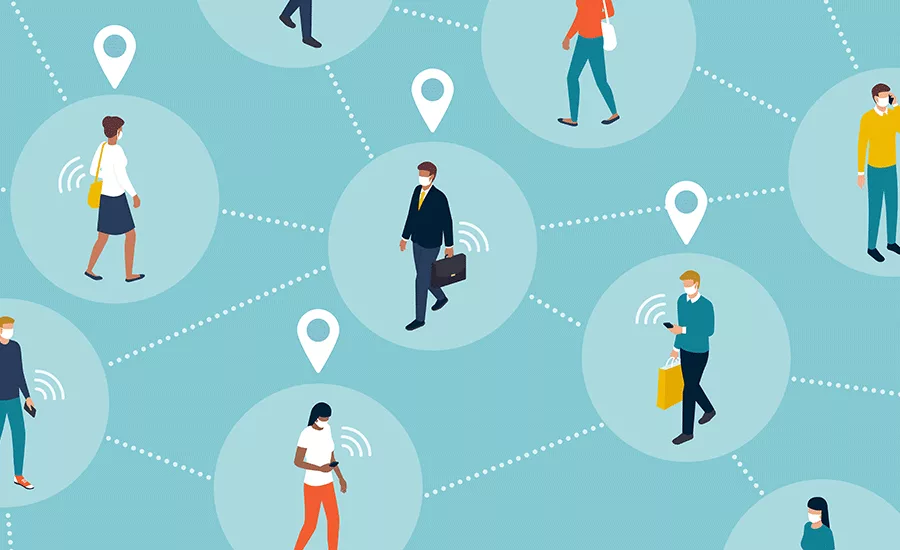Double duty: Location technologies for pandemic resilience and enhanced security

As organizations bring their employees back to the workplace, many are looking to leverage location technology as a means to increase safety. Return-to-work solutions ranging from digital contact tracing and social distancing monitoring to sanitation alerts and occupancy analytics are being explored and embraced in varying degrees around the world. However, it’s imperative that any technology deployed works a double shift to also provide value in the post-pandemic times. The same location technology infrastructure used to address infection prevention and mitigation can be used to complement and enhance traditional security efforts.
Indoor intelligence technologies span a wide range of connective systems that make buildings smarter and provide valuable insights that can be used to address health, safety and security needs. It all starts by knowing the location of people and assets, and placing them on a detailed, dynamic, digital map of the facilities. The positioning can be accomplished leveraging existing Wi-Fi infrastructure or additional radio frequency (RF) sensors with software specifically designed to locate cell phones, smart watches and other RF-emitting devices including visitor badges and asset tags. From there, the opportunities are nearly limitless, as services and specific applications can then be layered on top.
Let's take a look at some of the possibilities afforded by indoor intelligence that are changing the safety and security landscape, specifically, contact tracing, occupancy analytics, RF-enabled video analytics, and rogue wireless device detection.
Contact tracing can be a powerful tool to help reduce the spread of infections and may even become mandated by government regulators. With digital contact tracing, if a staff member reports an infection, location technologies can then be used to see not only with whom that person was in contact, in order to do possible exposure notification, but also to identify the areas and assets that may need to be deep cleaned. There may be no need to shut down entire wings or buildings if there is evidence that the infected individual never ventured to some parts of the building. While human resources personnel will likely take the lead in contact tracing, security departments may be involved.
Security officers may also be asked to monitor occupancy levels and crowding and to intervene when necessary. An indoor intelligence solution can enable staff to view zone-by-zone building health scores, which can be derived by looking at the number of wireless devices in a given area, device density (e.g., devices per square foot), and other factors. Building usage data can also be used to help proactively identify and mitigate high-traffic areas that may make it difficult to achieve adequate social distancing.
Traditional security challenges can also be addressed by leveraging these same location-aware technologies. Coronavirus masks are a boon for crooks who hide their faces, and law enforcement officials are seeing an increase in the number of criminals taking advantage of the pandemic to commit crimes, according to WUSA-TV. By detecting the wireless signals of cell phones, smart watches and other IoT wearables, and then correlating the RF device's presence to individual security video frames, security departments can address some of the tough, persistent challenges with traditional video surveillance. For instance, this RF-enabled video analytics solution can help to identify suspects even if their face is obscured, if they are in low- or no-light conditions, or if the suspect roams the building where cameras are not present.
Theft of intellectual property can also be combatted using RF location technology. A wireless device detection solution provides situational awareness of nearly all active wireless devices in the monitored environment. The technology locates rogue devices, such as unauthorized access points and eavesdropping equipment, and it enables the enforcement of no-phone zones. Further, when used in conjunction with a mobile device management system (MDM), the wireless device positioning solution can trigger the MDM to push more restrictive phone security policies (e.g., disable audio and video recording and wireless transmissions) when phones enter high security areas, and then lift such restrictions when the phone leaves the geofenced zone. These capabilities can help to not only increase security but also decrease enforcement personnel requirements and thwart attempted theft of company secrets.
As the prospect of a vaccine-aided post-pandemic world comes into view, many organizations are wondering how to balance current COVID-19 protocols and compliance concerns with future organizational needs. 95% of respondents to a recent survey during a CNN-moderated roundtable indicated that including future-proof solutions and technology in their return-to-work plan was important to them. While many are quick to point out the transferability of these technologies to overarching workplace optimizations, the link between return-to-work solutions and security is no less powerful despite perhaps being less obvious.
It is because of the shared need for location-awareness, post-event forensics, and focus on human safety that workplace readiness solutions like digital contact tracing are invariably also paving the way for future security excellence. Technology that cultivates situational awareness is a key component to both return-to-work solutions and security. This means that by embracing the former to keep buildings and the people inside them safe, you’re also laying the foundation to keep them secure as well.
This article originally ran in Security, a twice-monthly security-focused eNewsletter for security end users, brought to you by Security Magazine. Subscribe here.
Looking for a reprint of this article?
From high-res PDFs to custom plaques, order your copy today!






